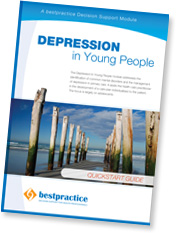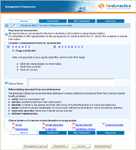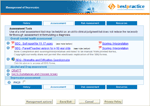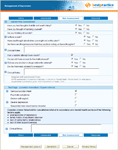Depression in Young People module

Introduction
The bestpractice Decision Support Depression in Young People module provides screening, assessment and management tools for health professionals to identify and treat adolescent depression in Primary Care. When the module is selected for a patient under 18 years of age, users are directed to assessment tools and resources developed and endorsed for adolescents. Eighteen years is a practical cut-off point that reflects the age used in most research but does not necessarily represent a developmental threshold.
Background
Young people are at high risk of mental disorders however the routine use of a screening tool for early intervention of young people is not recommended. Recent models of health promotion take a ‘strengths-based’ approach which focuses on enhancing resiliency and minimising obstacles to health development. This contrasts with the traditional biomedical model which focuses on problem identification and risk management.
The communication skills of the practitioner will help determine the likelihood of a disorder being diagnosed. Young people may not raise psychological concerns spontaneously and therefore need to be asked. A structured clinical assessment is key to identifying both problems and protective factors and because children tend to provide different information from their parents, it is helpful to gather information from both sources.
How it works
As with the bestpractice Adult Depression module, the module for Depression in Young People focuses on best practice guidelines developed for the New Zealand context. These guidelines provide evidence-based practice for most young New Zealanders in most circumstances. They form a basis for decision-making by the health care practitioner in discussion with the person and their whanau in developing an individualised care plan.
Standardised formats such as the HEEADSSS acronym for adolescents and HEARTS for young children will prompt clinicians to structure the history they take as clinical notes are recorded. The bestpractice Depression in Young People module also provides information on the clinical features of common mental disorders in young people and the criteria which can be used to help differentiate abnormal from normal behaviour.
Use of a brief assessment tool may be helpful as an aid to clinical judgement but does not reduce the necessity for through assessment in formulating a diagnosis. The Strengths and Difficulties Questionnaire (SDQ) has been considered the most robust tool for assessing overall mental health in young New Zealanders (from four years of age). It is provided as a Parent and Teacher version for four to ten year olds and as a self-report for 11-17 year olds. Separate assessment tools are also available for Alcohol and Drug (CRAFFT and SACS), and the PHQ-9 for Depression Assessment.
Assessing suicide risk in young people is challenging for practitioners as there are no markers to predict the presence or intensity of risk and assessment only provides a snapshot at a given time. Consequently monitoring of risk needs to be ongoing as new triggers can occur even if a person’s mental state is improving. Questions to assist in assessing this risk are offered to help practitioners distinguish passive from active suicidal ideation. Clinical notes can also be seamlessly recorded during the consultation allowing the vital communication and observational skills of the practitioner to form part of the record. This information is written back to the Patient’s Medical Record and included in any referrals.
The module then considers management options for this person based on the New Zealand Guidelines for the Identification of Common Mental Disorders and Management of Depression in Primary Care 2009. It is feasible and appropriate for most young people with depression to be managed within primary care, however forms for referral to secondary care mental health services are pre-populated by bestpractice if appropriate. Management options in primary care involving active support, self-management advice and patient resources appropriate for the age group are directly accessible through bestpractice.
Sometimes problems take several sessions to ‘unravel’ in the clinical setting and it is therefore vital to have records easily available for the future and to negotiate active follow-up. A patient recall is offered through the usual Patient Management System processes before exiting the module so re-assessment with a face-to-face visit can allow for intensified support if there is no improvement in symptoms. This on-going monitoring and adjustment to the intensity of intervention according to patient’s response provides a ‘stepped care’ approach.
External links
- New Zealand Guidelines Group. Identification of common mental disorders and management of depression in primary care. An evidences-based Best Practice Guideline. Published by New Zealand Guidelines Group; Wellington: 2008.
Featured module

The INR Monitoring module utilises a formula developed by Ryan et al which assists clinicians adjust oral anticoagulant doses in patients. It also recommends the time interval for the next follow up visit and prints a Patient Dose calendar if required.
For more modules see the full list of standard modules.
Latest News
ACC18 Enhancements - Effective 27 November
Calendar, Printing and ACC Identifiers
In response to feedback, the online ACC18 continues to launch enhancements; the following will be available from 27 November.
Fitness for Work Tab - Calendar: Moving the mouse over the calendar for longer periods has been made easier.
Declaration Tab - ACC Identification: There will be a reduction in the number of identifiers from five to four; no direct impact on the Provider.
If you are one of the over 2000 Practitioners who regularly use the online ACC18; thank you. If you are not then now would be a good time to begin, noting that additional return to work assistance for patients is offered solely through this online form. Self service for setting up and using the online ACC18 is available at www.acc.co.nz (use keyword eACC18 Self Service). However, feel free to contact ACC at 0800 222 994 or ebusinessinfo@acc.co.nz for more personalised support.
Most Popular Modules
The five most popular modules in June were:
- Patient Prompt
- The Common Form
- e-Referral System
- ACC 18 Form
- CVD Quick Screen
To see more, go to the Statistics page.
Getting Started guide
The Getting Started guide is a good place to start if you are new to bestpractice Decision Support. The articles in the guide provide a quick and focussed introduction to the areas of most interest to new users of bestpractice.
About BPAC Inc
bestpractice Decision Support is produced by BPAC Inc. To find out more about us, click here.











